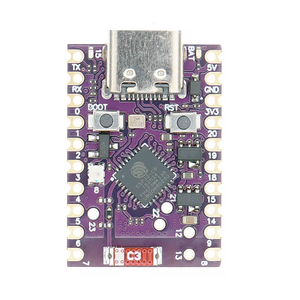
ESP32-C6 Super Mini is a development board based on the ESP32C6 microcontroller using RISCV32 architecture.
This board features a maximum CPU frequency of 160 MHz and 4MB flash memory.
About ESP32-C6 Super Mini
The ESP32-C6 SuperMini is a compact and powerful development board featuring the Espressif ESP32-C6 WiFi 6 and Bluetooth dual-mode chip. With support for IEEE 802.11ax WiFi 6 (2.4 GHz) and Bluetooth 5 (LE) with Bluetooth Mesh, it ensures fast and reliable wireless connectivity.
At its core, the ESP32-C6 SuperMini is powered by a RISC-V 32-bit single-core processor running at up to 160 MHz, offering efficient performance for IoT applications. It includes 512 KB of high-performance SRAM, 16 KB of low-power SRAM, and 4 MB of flash memory, giving your projects plenty of space to run smoothly.
Designed with ease of use in mind, the board comes with a USB Type-C interface for simple programming and connectivity. Plus, its compact form factor makes it ideal for space-constrained applications.
With versatile interfaces (UART, I2C, SPI) and a rich set of GPIOs, the ESP32-C6 SuperMini is a great choice.
🆚 Wondering how the ESP32-S3 SuperMini compares to other SuperMini boards? Check out our full comparison guide to see how it stacks up against the C3, C3 Plus, C6, and H2.
Where to Buy ESP32-C6 Super Mini
Prices are subject to change. We earn from qualifying purchases as an Amazon Associate.
📋 Technical Specifications
Complete technical specification details for ESP32-C6 Super Mini
🛰️ Connectivity
🧠 Microcontroller
✨ Features & Pins
- • Ultra-small size for embedded applications
- • Ultra-low power consumption with low-power working modes
- • RISC-V 32-bit single-core CPU running at up to 160 MHz
- • 512 KB high-performance SRAM and 16 KB low-power SRAM
- • WiFi 6 (802.11ax, 2.4 GHz) with 40 MHz bandwidth support
- • Bluetooth 5 (LE) and Bluetooth Mesh support
- • USB Type-C interface for programming and connectivity
- • Stamp hole design for direct soldering onto PCB
ESP32-C6 Super Mini Pinout Diagram
Complete pin reference for ESP32-C6 Super Mini

The ESP32-C6 Super Mini pinout is designed for versatile connectivity in a compact format. The board provides essential power pins such as 5V, 3.3V, and GND for stable power delivery.
It features dedicated communication interfaces including RX and TX for UART, SDA and SCL for I2C, and MISO, MOSI, SCK, and SS for SPI, ensuring seamless integration with peripherals.
For analog input, the ESP32-C6 Super Mini offers ADC pins labeled A0 to A5, supporting sensor applications. Additionally, it features a stamp hole design for direct soldering, providing improved reliability for embedded applications.
✅ Safe Pins to Use
These pins are safe for general GPIO usage without boot or system conflicts
💡 Why Are These Pins Safe?
⚠️ Pins to Avoid or Use with Caution
Reserved for critical functions. Misuse may cause boot failures, programming issues, or system conflicts.
Boot behavior & flash voltage
Low-level debugging interface
USB Serial/JTAG communication
Memory & PSRAM connections
Debugging & firmware uploads
| PIN | Label | Why Avoid | Type |
|---|---|---|---|
| IO4 | MTMS | Used during boot; required for JTAG debugging; flash data in internal-flash models. | 🛠️ Strapping |
| IO5 | MTDI | Used during boot; required for JTAG debugging; flash data in internal-flash models. | 🛠️ Strapping |
| IO6 | MTCK | Required for JTAG debugging; connected to flash clock in internal-flash models. | 🔗 JTAG |
| IO7 | MTDO | Required for JTAG debugging; connected to flash data in internal-flash models. | 🔗 JTAG |
| IO8 | GPIO8 | Determines boot mode; pulling low at reset can prevent normal boot. | 🛠️ Strapping |
| IO9 | GPIO9 | Pulling low on reset forces the ESP32-C6 into download mode instead of normal boot. | 🛠️ Strapping |
| IO12 | USB_D- | Dedicated to USB communication; avoid if using USB functionality. | 🔌 USB |
| IO13 | USB_D+ | Dedicated to USB communication; avoid if using USB functionality. | 🔌 USB |
| IO15 | JTAG_SEL | Controls JTAG input source at boot; avoid altering its state. | 🔗 JTAG |
| IO18 | FSPIQ | Connected to internal flash; using as GPIO can disrupt flash operations. | ⚡ Flash |
| IO19 | FSPID | Connected to internal flash; using as GPIO can disrupt flash operations. | ⚡ Flash |
On-Board LEDs
LED indicators on ESP32-C6 Super Mini
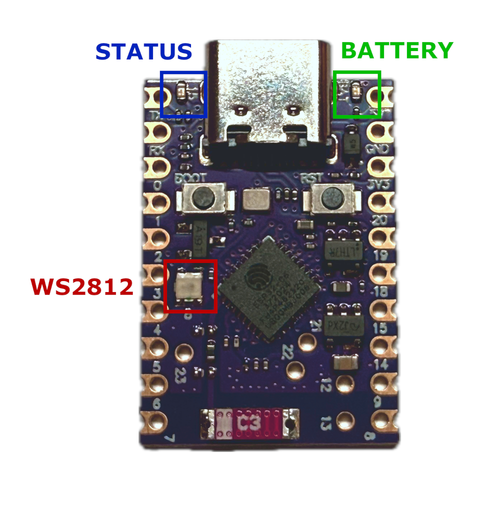
The ESP32-C6 Supermini features three onboard LEDs: a green battery indicator, a user-controllable status LED, and a WS2812 RGB LED. The WS2812 is connected to GPIO8, while the simple status LED is on GPIO15.
🟢 Green LED – Battery Charge Indicator
- GPIO:
None - Control: Not controllable via GPIO
- Behavior:
- ⚡ Charging → LED on
- ✅ Battery connected → LED off
- 🔋 No battery → LED blinks
🔵 Status LED – User Controllable
- GPIO:
GPIO15 - Control:
digitalWrite(), ESPHome GPIO output
void setup() {
pinMode(15, OUTPUT);
}
void loop() {
digitalWrite(15, HIGH);
delay(1000);
digitalWrite(15, LOW);
delay(1000);
}
output:
- platform: gpio
pin: 15
id: status_led
light:
- platform: binary
name: "Status LED"
output: status_led
🌈 WS2812 LED – Programmable RGB
- GPIO:
GPIO8 - Control: FastLED, NeoPixel, etc.
#include <FastLED.h>
#define NUM_LEDS 1
#define DATA_PIN 8
CRGB leds[NUM_LEDS];
void setup() {
FastLED.addLeds<NEOPIXEL, DATA_PIN>(leds, NUM_LEDS);
}
void loop() {
leds[0] = CRGB::Red; FastLED.show(); delay(1000);
leds[0] = CRGB::Green; FastLED.show(); delay(1000);
leds[0] = CRGB::Blue; FastLED.show(); delay(1000);
light:
- platform: esp32_rmt_led_strip
chipset: WS2812
pin: GPIO8
num_leds: 1
rgb_order: GRB
name: "Onboard RGB LED"Useful Links
Datasheets and resources for ESP32-C6 Super Mini
ESP32-C6 Super Mini Custom Pin Mapping
Pin configuration and GPIO mapping for ESP32-C6 Super Mini
| Pin | Function | ESP Pin | I/O Type | Description |
|---|---|---|---|---|
| 1 | 5V | 5V | POWER INPUT | 5V power input for the board |
| 2 | GND | GND | POWER GROUND | Ground connection |
| 3 | 3V3 | 3.3V | POWER OUTPUT | 3.3V power output for peripherals |
| 4 | TX | TX | TX | TX |
| 5 | RX | RX | RX | RX |
| 6 | IO0 | GP0 | BIDIRECTIONAL | GPIO, ADC pin |
| 7 | IO1 | GP1 | BIDIRECTIONAL | GPIO, ADC pin |
| 8 | IO2 | GP2 | BIDIRECTIONAL | GPIO, ADC pin |
| 9 | IO3 | GP3 | BIDIRECTIONAL | GPIO, ADC pin |
| 10 | IO4 | GP4 | BIDIRECTIONAL | GPIO, ADC pin |
| 11 | IO5 | GP5 | BIDIRECTIONAL | GPIO, ADC pin |
| 12 | IO6 | GP6 | BIDIRECTIONAL | GPIO, ADC pin |
| 13 | IO7 | GP7 | BIDIRECTIONAL | GPIO |
| 14 | IO8 | GP8 | BIDIRECTIONAL | GPIO, RGB LED |
| 15 | IO9 | GP9 | BIDIRECTIONAL | GPIO, Boot |
| 16 | IO12 | GP12 | BIDIRECTIONAL | GPIO |
| 17 | IO13 | GP13 | BIDIRECTIONAL | GPIO |
| 18 | IO14 | GP14 | BIDIRECTIONAL | GPIO |
| 19 | IO15 | GP15 | BIDIRECTIONAL | GPIO, LED |
| 20 | IO18 | GP18 | BIDIRECTIONAL | GPIO |
| 21 | IO19 | GP19 | BIDIRECTIONAL | GPIO |
| 22 | IO20 | GP20 | BIDIRECTIONAL | GPIO |
| 23 | IO21 | GP21 | BIDIRECTIONAL | GPIO |
| 24 | IO22 | GP22 | BIDIRECTIONAL | GPIO |
| 25 | IO23 | GP23 | BIDIRECTIONAL | GPIO |
Pin Mappings
Complete pinout and GPIO mapping for ESP32-C6 Super Mini
| Pin | Analog | Touch | PWM | Other |
|---|---|---|---|---|
| 0 | A0 | |||
| 1 | A1 | |||
| 2 | A2 | |||
| 3 | A3 | |||
| 4 | A4 | SCK | ||
| 5 | A5 | MISO | ||
| 6 | MOSI | |||
| 7 | SS | |||
| 8 | SDA | |||
| 9 | SCL | |||
| 20 | RX | |||
| 21 | TX |
Default Tools & Configuration
Build and upload settings for ESP32-C6 Super Mini
| Setting | Value |
|---|---|
| Bootloader tool | esptool_py |
| Uploader tool | esptool_py |
| Network uploader tool | esp_ota |
| Bootloader address | 0x0 |
| Flash mode | qio |
| Boot mode | qio |
| Maximum upload size | 1280 KB (1310720 bytes) |
| Maximum data size | 320 KB (327680 bytes) |
The ESP32-C6 Super Mini uses esptool_py for uploads , esp_ota for OTA updates, and esptool_py bootloader at 0x0.
Flash mode: qio | Boot mode: qio
Max sketch size: 1280 KB | Max data size: 320 KB
Similar Boards
Other development boards with ESP32C6 microcontroller
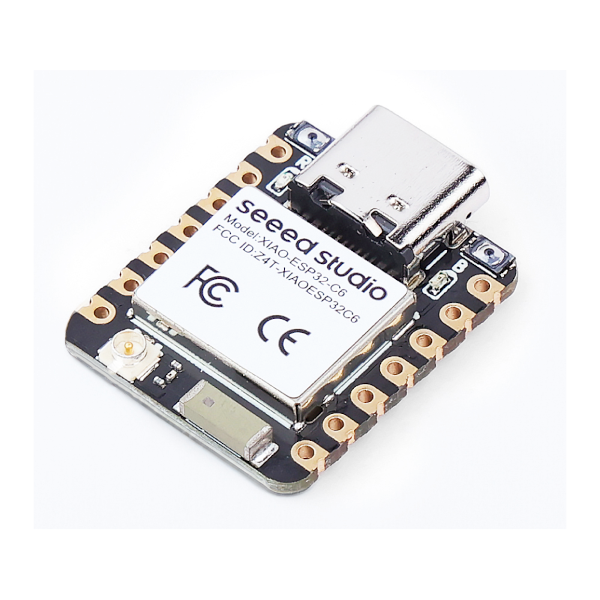
XIAO ESP32C6
XIAO ESP32C6 development board is based on esp32c6 microcontroller and uses riscv32 architecture.
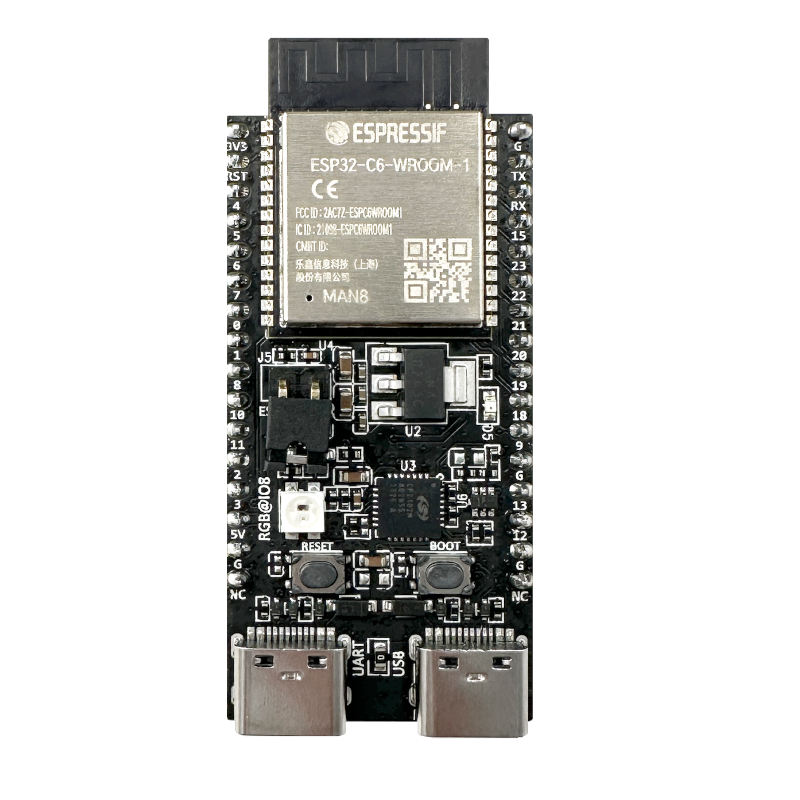
Espressif ESP32-C6-DevKitC-1
Espressif ESP32-C6-DevKitC-1 development board is based on esp32c6 microcontroller and uses riscv...
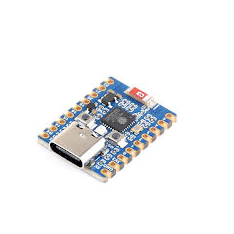
ESP32 C6 Zero Mini
ESP32 C6 Zero Mini development board is based on esp32c6 microcontroller and uses riscv32 architecture.



